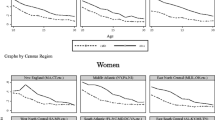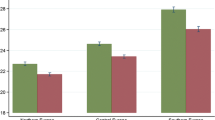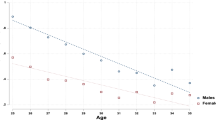Abstract
We use retrospective life-history data from the Survey of Health, Ageing and Retirement in Europe to assess parental altruism through the effect of parental resources and home characteristics on the age at which individuals now aged 50 or more left the nest in 13 countries. We show that the nest leaving age has declined from one cohort to the next and that the tendency has been of a relative decline in leaving one’s parents to start a family and an increase in leaving home to pursue higher education, even if the first pattern was still the most common for the baby-boomers. We test an altruistic model where constrained parents push the child out, where less constrained “proximity altruistic” parents can help the child by providing a home or even, for the richest “active altruists”, help the child leave the nest. Taking into account the endogenous child’s choices of education, we find that most parents helped by being proximity altruists, while some helped their children move out and that the quality of the home had an important influence on the nest leaving age.




Similar content being viewed by others
Notes
The child does not share in Ermisch and Di Salvo (1997), Rosenzweig and Wolpin (1993), Manacorda and Moretti (2006), or Le Blanc and Wolff (2005). There is perfect income pooling when co-residence in Diaz and Guilló (2005) or Becker et al. (2010). In Börsch-Supan (1986) housing costs are shared between parents and co-residing child. De Regt (2004) analyses how Dutch children of working class families evolved from co-providers to consumers over the twentieth century. We come back to the question of income sharing in the empirical section.
The question was asked in the same fashion in all countries and accompanied by an instruction: “If asked, the year the respondent views as his/her first own household after the parental home. Please code 9997 if respondent never established own household”. We exclude from our analysis those who report to have never left the parental house (2.5 % of the sample, see Angelini et al. 2011, for a discussion).
Information on more recent trends can be gathered from what respondents tell about the age at which their own children moved from the parental household. For the younger cohorts (1955–1964) the decline in nest leaving age has stopped and also reversed (for cohort 1965–1974) in the Southern European countries, in France and Belgium (see Angelini et al. 2011 for details).
Six groups with strict inequality in ages, plus seven groups when we add possible equality in ages.
Only 5 types comprise 5% or more of the sample so we regrouped the 7 types covering all the remaining cases (each between 0.07 and 1.69%), adding them to the nearest group (types 2, 4 or 5) on the basis of their mean age at nest leaving and finishing education. Those who never married (4.6%) are classified according to the age they left education.
Be they “absolute nuclear” as the Netherlands and Denmark, or “egalitarian nuclear” as France, Italy, Spain, or Greece. The way anthropologists or historians classify the countries vary (e.g. Esping Andersen, versus Todd). This is not surprising as the limits of countries are sometimes fairly recent, and as some traditions have influenced broad areas (e.g. The Napoleonic Civil Code, itself an heir to Roman Code) and people have been mobile. Todd points to different family traditions, going back to the Middle Ages, opposing the absolute nuclear family (with freedom for the parents to divide the estate unequally), to the egalitarian nuclear family type (with Northern Italy being of a fourth Communitarian type, Northern Spain being of the Stem type and France being a mixture of all types), and the authoritarian stem family type (Germany, Austria, Switzerland, Belgium and the Czech Republic). It has been shown that such traditions are closely related to the current various pension systems (Galasso and Profeta 2011), and to other outcomes at the regional level (Duranton et al. 2008).
Poland is classified as “egalitarian nuclear” in Todd (according to Galasso and Profeta 2011) but the move of the boundaries to the West makes it closer to a stem family pattern in that respect.
For those who got married. One in five in this group never got married.
5 % of them did not get married.
12 % did not get married.
Number of siblings was never significant. We dropped it since it does not change any result.
Defined as number of rooms per person below 0.5.
0.669 + 0.803 = 1.472.
In a different bargaining context, Pezzin et al. (2009) provide evidence that elderly step-parents do not provide the same incentives for care giving.
High-skilled (manager, professional). Medium-skilled (technician, clerk, armed force). Low-skilled (shop assistant, agriculture, craft, blue collar, elementary and no occupation).
It could also be that Dutch children of working class families stayed to help the family with their income, as mentioned by de Regt (2004). The country sample is too small to probe this further.
Those who left a parental home situated in a foreign country also left younger. They were left aside from former models.
This is computed from running 3 successive models of the nest leaving age, adding to country and cohort effect, the same control as those in model (3) of Table 1, then the age at marriage and the age at the end of education.
See Angelini et al. (2011) for a discussion on the influence of context variables such as the housing market policies on nest leaving age.
This has been pointed by some sociologists. For instance Avery et al. (1992) conclude that it is important to separate those who leave to marry from others.
The results are available upon request from the authors.
Nilsson and Strandh (1999), on Swedish data found that higher parental earnings are connected with a greater probability of nest leaving for men. They found that for women, a working-class background was linked with an increased probability of nest leaving.
The sons of a father in the armed force also leave 1–2 years earlier which can be understood as no further education might be provided where the parents live and the parents move around a lot.
References
Aassve, A., Billari, F. C., & Piccarreta, R. (2007). Strings of adulthood: A sequence analysis of young British women’s work-family trajectories. European Journal of Population/Revue européenne de Démographie, 23, 369–388.
Aassve, A., Burgess, S., Chesher, A., & Propper, C. (2002). Transition from home to marriage of young Americans. Journal of Applied Econometrics, 17, 1–23.
Alessie, R., Brugiavini, A., & Weber, G. (2006). Saving and cohabitation: the economic consequences of living with one’s parents in Italy and The Netherlands. In R. H. Clarida, J. A. Frankel, F. Giavazzi, & K. D. West (Eds.), NBER international seminar on macroeconomics 2004 (pp. 413–441). Cambridge, MA: MIT Press.
Angelini, V., Laferrère, A., & Pasini, G. (2011). Nest leaving in Europe. In A. Börsch-Supan, M. Brandt, K. Hank, & M. Schröder (Eds.), The individual and the welfare state, life histories in Europe (pp. 67–97). Heidelberg: Springer.
Avery, R., Goldscheider, E., & Speare, A. (1992). Feathered nest/gilded cage: Parental income and leaving home in the transition to adulthood. Demography, 29, 375–388.
Barnet-Verzat, C., & Wolff, F.-C. (2002). Motives for pocket money allowance and family incentives. Journal of Economic Psychology, 23, 339–366.
Becker, G. (1991). A treatise on the family. Cambridge, MA: Harvard University Press.
Becker, S., Bentolila, S., Fernandes, A., & Ichino, A. (2010). Youth emancipation and perceived job insecurity of parents and children. Journal of Population Economics, 23, 1047–1071.
Billari, F., & Tabellini, G. (2010). Italians are late: Does it matter? In J. B. Shoven (Ed.), Demography and the economy, NBER Books (pp. 371–412). Chicago: University of Chicago Press.
Börsch-Supan, A. (1986). Household formation, housing prices, and public policy impacts. Journal of Public Economics, 30, 145–164.
Case, A., & Paxson, C. (2009). Early life health and cognitive function in old age. American Economic Review, 99, 104–109.
Chiuri, M. C., & Del Boca, D. (2010a). Household membership decisions of adult children: exploring European diversity. Labour, 24(Special Issue), 3–24.
Chiuri, M. C., & Del Boca, D. (2010b). Home-leaving decisions of daughters and sons. Review of Economics of the Household, 8, 393–408.
Cox, D. (1987). Motives for private income transfers. Journal of Political Economy, 95, 508–546.
de Regt, A. (2004). Children in the 20th-century family economy: From co-providers to consumers. History of the Family, 9, 371–384.
Diaz, A., & Guilló, D. (2005). Family ties and labor supply. Investigaciones Economicas, 29, 289–329.
Duranton, G., Rodríguez-Poseand, A., & Sandall, R. (2008). Family types and the persistence of regional disparities in Europe. Spatial Economic Research Centre, WP, 9.
Elzinga, C. H., & Liefbroer, A. C. (2007). De-standardization of family-life trajectories of young adults: A cross-national comparison using sequence analysis. European Journal of Population/Revue européenne de Démographie, 23, 225–250.
Engers, M., & Stern, S. (2002). Long-term care and family bargaining. International Economic Review, 43, 73–114.
Ermisch, J. (1999). Prices, parents, and young people’s household formation. Journal of Urban Economics, 45, 47–71.
Ermisch, J. (2003). An economic analysis of the family. Princeton: Princeton University Press.
Ermisch, J., & Di Salvo, P. (1997). The economic determinants of household formation. Economica, 64, 627–644.
Fogli, A. (2004). Endogenous labor market rigidities and family ties. Mimeo, New York University.
Galasso, V., & Profeta, P. (2011). When the state mirrors the family: the design of pension systems. Working paper no. 392, IGIER Università Bocconi.
Ganzeboom, H. B. G., De Graaf, P. M., & Treiman, D. (1992). A standard international socio-economic index of occupational status. Social Science Research, 21, 1–56.
Garrouste, C. (2010). 100 years of educational reforms in Europe: A contextual database. European Commission, JRC Scientific and Technical Reports.
Haurin, R., Hendershott, P., & Kim, D. (1992). The impact of real wages and rents on household formation. Review of Economics and Statistics, 75, 284–293.
Kulis, S. (1992). Social class and the locus of reciprocity in relationships with adult children. Journal of Family Issues, 13, 482–504.
Laferrère, A. (2005a). Leaving the nest: The interaction of parental income and family environment. INSEE WP 2005-01.
Laferrère, A. (2005b). Quitter le nid: entre forces centripètes et centrifuges. Économie et Statistique, 381–382, 147–175.
Laferrère, A., & le Blanc, D. (2004). Gone with the windfall: How do housing allowances affect student co-residence? CESifo Economic Studies, 50, 451–477.
le Blanc, D., & Wolff, F.-C. (2005). Leaving home in Europe: The role of parents’ and children’s incomes. Review of Economics of the Household, 4, 53–73.
Lesnard, L., Cousteaux, A.-S., Chanvril, F., & Le Hay, V. (2010). Do transitions to adulthood converge in Europe? An optimal matching analysis of work-family trajectories of young adults from 20 European countries. Notes et documents 2010-04, Paris, OSC, Sciences Po/CNRS.
Manacorda, M., & Moretti, E. (2006). Why do most Italian youths live with their parents? Intergenerational transfers and household structure. Journal of the European Economic Association, 4, 800–829.
Martins, N., & Villanueva, E. (2009). Does high cost of mortgage debt explain why young adults live with their parents? Journal of the European Economic Association, 7, 974–1010.
McElroy, M. (1985). The joint determination of household membership and market work: The case of young men. Journal of Labor Economics, 3, 293–316.
Nelson, J. (1988). Household economics of scale in consumption: Theory and evidence. Econometrica, 56, 1301–1314.
Nilsson, K., & Strandh, M. (1999). Nest leaving in Sweden, the importance of early educational and labor market careers. Journal of Marriage and Family, 61, 1068–1079.
Pezzin, L. E., Pollak, R. A., & Schone, B. S. (2007). Efficiency in family bargaining: Living arrangements and caregiving decisions of adult children and disabled elderly parents. CESifo Economic Studies, 53, 69–96.
Pezzin, L. E., Pollak, R. A., & Schone, B. S. (2009). Long-term care of the disabled elderly: Do children increase caregiving by spouses? Review of Economics of the Household, 7, 323–339.
Rosenzweig, M., & Wolpin, K. (1993). Intergenerational support and the life-cycle incomes of young men and their parents: Human capital investments, coresidence, and intergenerational financial transfers. Journal of Labor Economics, 11, 84–112.
Acknowledgments
We are grateful to two anonymous referees for helpful comments and suggestions. This paper uses data from SHARELIFE release 1, as of November 24th 2010 or SHARE release 2.4.0, as of March 17th 2010. The SHARE data collection has been primarily funded by the European Commission through the 5th framework programme (project QLK6-CT-2001-00360 in the thematic programme Quality of Life), through the 6th framework programme (projects SHARE-I3, RII-CT-2006-062193, COMPARE, CIT5-CT-2005-028857, and SHARELIFE, CIT4-CT-2006-028812) and through the 7th framework programme (SHARE-PREP, 211909 and SHARE-LEAP, 227822). Additional funding from the U.S. National Institute on Aging (U01 AG09740-13S2, P01 AG005842, P01 AG08291, P30 AG12815, Y1-AG-4553-01 and OGHA 04-064, IAG BSR06-11, R21 AG025169) as well as from various national sources is gratefully acknowledged (see www.share-project.org for a full list of funding institutions).
Author information
Authors and Affiliations
Corresponding author
Appendix: Derivations of the empirical predictions in Table 1
Appendix: Derivations of the empirical predictions in Table 1
The child has four possible utility levels depending on the co-residence status and on whether the parent makes a transfer:
In each case, the child decides whether to leave or not depending on the sign of V i − V c. Then, the partial derivatives of V i − V c give the effect of Y p , β, n, δ, ρ k and \( \bar{H} \) on the probability of leaving the nest which are summarized in Table 1.
Income effects
-
1.
If T c > 0 and T i > 0:
$$ \frac{{\partial (V^{i} - V^{c} )}}{{\partial Y_{p} }} = \frac{{\partial (V^{i} - V^{c} )}}{{\partial Y_{k} }} = \frac{1 - \alpha }{{\bar{Y}_{p} + Y_{k} }} > 0 $$The sign is the same if T c = 0 and T i > 0.
$$ \frac{{\partial (V^{i} - V^{c} )}}{{\partial \beta^{i} }} = \frac{\gamma }{{\beta^{i} \left( {\gamma + \beta^{i} } \right)}} > 0 $$ -
2.
If T c > 0 and T i = 0:
$$ \begin{aligned} \frac{{\partial (V^{i} - V^{c} )}}{{\partial Y_{p} }} & = - \frac{\alpha }{{\bar{Y}_{p} + Y_{k} }} < 0 \\ \frac{{\partial (V^{i} - V^{c} )}}{{\partial Y_{k} }} & = \frac{{\bar{Y}_{p} + (1 - \alpha )Y_{k} }}{{Y_{k} (\bar{Y}_{p} + Y_{k} )}} > 0 \\ \frac{{\partial (V^{i} - V^{c} )}}{{\partial \beta^{c} }} & = - \frac{\alpha \gamma }{{\beta^{c} \left( {\gamma + \beta^{c} \alpha } \right)}} < 0 \\ \end{aligned} $$ -
3.
If T c = 0 and T i = 0:
$$ \begin{aligned} \frac{{\partial (V^{i} - V^{c} )}}{{\partial Y_{p} }} & = 0 \\ \frac{{\partial (V^{i} - V^{c} )}}{{\partial Y_{k} }} & = \frac{1 - \alpha }{{Y_{k} }} > 0 \\ \end{aligned} $$
Other effects
In all cases:
Rights and permissions
About this article
Cite this article
Angelini, V., Laferrère, A. Parental altruism and nest leaving in Europe: evidence from a retrospective survey. Rev Econ Household 11, 393–420 (2013). https://doi.org/10.1007/s11150-012-9170-9
Received:
Accepted:
Published:
Issue Date:
DOI: https://doi.org/10.1007/s11150-012-9170-9




